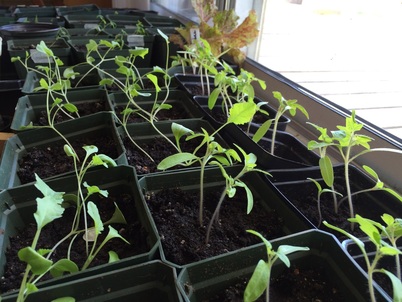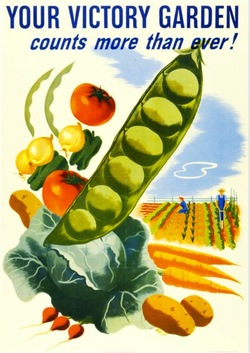 Baby broccoli and tomatoes -- and yes, they need to be thinned soon!
Baby broccoli and tomatoes -- and yes, they need to be thinned soon! 
In World War II, millions of American turned to their backyards to 'Garden for Victory,' growing food for domestic consumption in order to relieve civilian demands on the national food supply, to increase their health and wellness, to save on war materials like gasoline, rubber, and tin used in packing and transporting food to consumers, and to visibly demonstrate their patriotism.
In 1943, over 20 million Americans in their Victory Gardens produced 42% of the fresh produce United States citizens consumed that year. That makes Victory Gardens the most successful local food movement of the American 20th century.
Odds are, if your family was living in the United States during World War II, someone in your family was a Victory Gardener; even if they didn't have a backyard, community gardens sprung up in city parks, factories offered their employees pre-plowed plots on site, and rooftop gardens appeared even in downtown NYC. My dissertation goes into many more of the who-what-where-when-why-hows, but one of my central questions is: "What did these gardens mean?" I decided one way to answer that question, outside the archives, was to grow one myself.
- To grow a garden that provides a significant portion of my (and my partner's) produce for the summer.
- To follow World War II Victory Garden plot design, instructions, and advice to the letter where reasonable and in spirit where it is not. (I anticipate a post or five later in summer about the sheer quantity and dangerous quality of pesticides, herbicides, fungicides, and insecticides recommended in certain USDA Extension Service pamphlets.)
- To cultivate a practice of public writing; to wring the words out of me until the trickle becomes an unstoppable flood. In this way, I hope to stimulate broader historical thinking about our modern food systems and our relationship with the environment through food.
Coming in the near future: a post about the first step in any Victory Garden: planning my plot (AKA choosing from a variety of WW2 sample plot designs. The visuals are awesome.)
 RSS Feed
RSS Feed